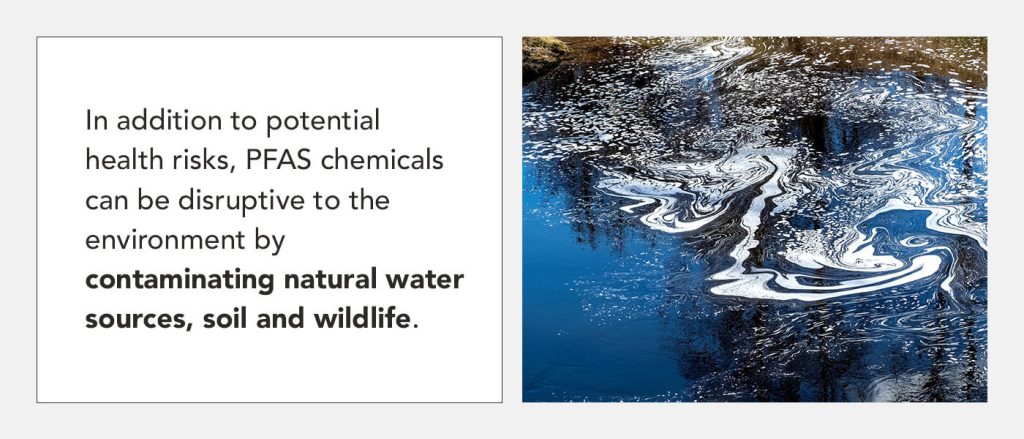Per- and polyfluoroalkyl substances (PFAS) chemicals have been used in numerous industrial and consumer products since the 1940s. However, companies and organizations are starting to impose restrictions on PFAS as they discover their potentially damaging effects. For instance, in March 2023, the United States Environmental Protection Agency (EPA) proposed the first-ever national drinking water standard to limit PFAS chemicals.
PFAS has served many products in the manufacturing industry worldwide for decades, but these chemicals’ shortcomings should not be overlooked. Researchers are still exploring the effects of PFAS, but studies suggest a variety of environmental and human health risks. Learn about the meaning of PFAS chemicals, their uses and dangers in this guide.
Also referred to as “forever chemicals,” per- and polyfluoroalkyl substances are synthetic compounds used to manufacture everyday items. Products and coatings made from PFAS chemicals are usually designed to resist staining, water, heat, grease and oil. These chemicals contain long-chain, carbon-fluorine molecules that lack uniform structure, giving them nonstick properties.
PFAS chemicals are found in the following items and more:
PFAS chemicals are prevalent in textile manufacturing. The industry commonly uses them to improve fabric performance against food stains and liquid spills. These chemicals can also provide high thermal stability and durability, helping textiles withstand the washing and dry cleaning processes. Despite their characteristic properties and many uses, PFAS chemicals can be cause for concern.
PFAS chemicals can migrate into water, soil and air during production and use. They don’t break down in the environment, allowing them to flow through soil and pollute drinking water sources. They can also bioaccumulate, or build up, in fish and other wildlife. Moreover, they have been linked to numerous adverse health effects, putting users at risk.
Due to their widespread use and environmental presence, PFAS can be found in the blood of animals and people around the globe. Additionally, these chemicals are often present in low levels in various food products. Certain PFAS chemicals can accumulate in people and animals with consistent exposure over time.
What are the effects of this exposure? Below, we’ll explore the potential dangers of PFAS chemicals in more detail.
PFAS chemicals can be present in drinking water, air and soil. As mentioned above, they’re also present in many of the household items we use daily, from cookware and food packaging to personal care items.
This provides multiple ways for humans to be exposed to PFAS chemicals, whether inhaling them, drinking them, getting them on their skin or consuming food grown in PFAS-contaminated soil.
You can also be exposed to PFAS by accidentally swallowing contaminated dust or soil, or eating fish caught from contaminated water. While anyone can be exposed, people involved in manufacturing or processing PFAS-chemical products are at the highest risk.
More research is needed to better understand the health effects of PFAS. However, studies suggest that these chemicals are associated with the following health concerns:

In addition to potential health risks, PFAS chemicals can be disruptive to the environment by contaminating natural water sources, soil and wildlife. Research also suggests that PFAS exposure can harm plant cell structure, disturbing processes like photosynthesis, protein synthesis, gene expression, and carbon and nitrogen metabolisms.
State legislators are growing more aware of PFAS chemicals’ associated health risks, so many have issued guidelines to protect their residents’ health. Some states have banned PFAS chemicals in certain consumer products. Others have enforced more stringent water quality standards and cleanup and remediation efforts.
Maine’s 2021 law bans PFAS chemicals in all new consumer products with the exception of those essential for health and safety purposes. This measure will take effect in 2030. Few states — if any — have passed a ban as extensive as Maine’s. However, many states — including Colorado, Hawaii, California and others — have enacted laws eliminating PFAS in cosmetics, food packaging, firefighting foam, textiles and other products.
Even so, advocates encourage federal action against multinational corporations responsible for contamination, cleaning of infected waterways and sweeping PFAS bans for new products. As more lawmakers and state agencies learn about the harms of PFAS chemicals, more changes are expected to come.
PFAS regulations are becoming more stringent as studies reveal the negative effects of these chemicals. Many household items no longer contain PFAS, and manufacturers are seeking safer and eco-friendlier alternatives that offer the same performance.
Swavelle Group understands the harmful effects PFAS chemicals can have on the environment and human health. We strive to provide customers with quality, sustainable textiles that are free of harmful chemicals, including PFAS.
We work diligently with our suppliers to create safer, alternative products, keeping both our planet and customers’ health a top priority. We manufacture our Swavelle USA and Bella Dura™ products with natural, upcycled and recycled yarns. This allows us to save water and energy without contributing harmful industrial waste.
Our Bella Dura™ performance fabric starts as a synthetic or natural fiber by-product, ending its life as a fully recyclable product. Contrary to the traditional wet process, we solution-dye the yarn to cut down significantly on energy and water usage. These solution-dyed fabrics are bleach cleanable and resist ultraviolet (UV) rays, fading and staining.
Bella Dura™ performance fabrics can add both style and sustainability to high-traffic areas. They can withstand the toughest environments, provide easy-cleaning capabilities and enrich any space’s aesthetic, all while offering the PFAS-free product you desire.
Likewise, our Swavelle USA fabrics use certified recycled, post-industrial cotton and polyester yarns. These yarns are manufactured from apparel waste, then processed back into usable fibers. These fibers give the textile optimal softness, bringing both luxury and comfort to any space.
We don’t use any additional dyes or chemicals, ensuring substantial water and energy savings and no environmental pollution. Our process eliminates the need to plant new cotton and helps keep waste out of landfills. Swavelle USA products can bring organic beauty, plushness, expertly designed weaves and sustainability into any space.
Our sustainable fabrics can be used in every market we serve, whether outdoor, residential, RV or contract. If you’re looking to supply your customers with textiles that delight the eye and planet alike, Swavelle Group is ready to meet your needs with environmentally conscious products.

Our team at Swavelle Group is committed to making eco-friendly decisions about every product we design, keeping our employees, customers, suppliers and environment free of harmful PFAS chemicals. All of our textiles are inherently PFAS-free for those who desire style, performance and durability without the risk of chemical exposure.
We always pledge to keep sustainability at the forefront of our production process. That means choosing recycled over non-recycled materials. We also promote employee volunteerism and giving to strengthen our community and spread our message of sustainability.
When you turn to Swavelle Group for your high-quality textile needs, you’re choosing a company that goes above and beyond to minimize its environmental impact. Contact us today to learn more about our products and sustainability efforts.